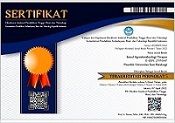Study Of Types Of Weeds That Have The Potential As Traditional Medicine Ingredients Used By The Community In North Bolaang Mongondow Regency
DOI:
https://doi.org/10.35791/jat.v5i1.52655Abstract
This research aims to obtain data on weed types that have the potential to be used as medicinal plants and are used by the community in the district. North Bolaang Mongondow Includes 1). Sangkub District, 2) Bintauna District, 3) Kaidipang District, 4) Pinogaluman District. The methods used in this research were field observations and interviews with healers and people who use weed as a traditional medicinal plant. The data/samples that will be taken over 4 sub-districts. The ethnic diversity that exists in Indonesia means that the use of weed as medicine is increasingly diverse. North Sulawesi Province has a wealth of plants as traditional medicines which can be processed to national standards into herbal medicines. The indigenous population in North Bolaang Mongondow Regency consists of the Kaidipang tribe and the Bintauna tribe. Various ethnic groups, including the Sangihe ethnic group and the Mongondow ethnic group, still use weed as an ingredient in traditional medicine. Weeds are wild plants defined as nuisance plants because they interfere with farmers' activities in cultivating crops and can reduce crop production. Apart from disturbing cultivated plants, weeds can be used as medicinal raw materials. Many types of weeds are used by the community as traditional medicine. Certain types of weed have been developed in the form of industrial-scale medicines. These weed species include Peperomia pellucida (L.), Cyperus rotundus L., Heliotropium indicum L., Eleusine indica (L.) Gaernt, Ageratum conyzoides L. The results of the research show that people in East Bolaang Mongondow Regency still use weed as a mixture of traditional medicinal ingredients.
Keywords: medicinal plants, potential of weeds as medicinal plants
Abstrak
Tujuan penelitian ini adalah memperoleh data jenis gulma yang berpotensi sebagai tumbuhan obat dan dimanfaatkan masyarakat di Kab. Bolaang Mongondow Utara Meliputi 1). Kecamatan Sangkub, 2) Kecamatan Bintauna, 3) Kecamatan Kaidipang, 4) Kecamatan Pinogaluman. Metode yang digunakan dalam penelitian ini adalah observasi lapangan, wawancara pengobat dan masyarakat pengguna gulma sebagai tumbuhan obat tradisional. Data/sampel yang akan diambil meliputi 4 kecamatan. Keanekaragaman etnis yang ada di Indonesia menyebabkan pemanfaatan gulma sebagai obat juga semakin beraneka ragam. Provinsi Sulawesi Utara memiliki kekayaan tumbuhan sebagai obat tradisional yang bisa diolah berstandar nasional menjadi obat herbal. Penduduk asli di Kabupaten Bolaang Mongondow Utara terdiri dari suku Kaidipang dan Suku Bintauna. Berbagai etnis diantaranya etnis Sangihe, etnis Mongondow masih erat menggunakan gulma sebagai bahan obat tradisional. Gulma merupakan tumbuhan liar didefinisikan sebagai tumbuhan pengganggu karena mengganggu kegiatan petani dalam budidaya tanaman dan dapat menurunkan produksi tanaman. Gulma selain mengganggu tanaman budidaya, dapat dimanfaatkan sebagai bahan baku obat. Banyak jenis gulma yang dimanfaatkan oleh masyarakat sebagai obat tradisional. Ada jenis gulma tertentu sudah dikembangkan dalam bentuk obat skala industri. Spesies gulma tersebut antara lain Peperomia pellucida (L.), Cyperus rotundus L., Heliotropium indicum L., Eleusine indica (L.) Gaernt, Ageratum conyzoides L. Hasil penelitian menunjukkan bahwa masyarakat di Kabupaten Bolaang Mongondow Timur masih menggunakan gulma sebagai campuran ramuan obat tradisional.
Kata kunci: tumbuhan obat, potensi gulma sebagai tumbuhan obat.
Downloads
Published
How to Cite
Issue
Section
License
Copyright (c) 2024 Rinny Mamarimbing, Beatrix Doodoh, Pemmy Tumewu, Antje Grace Tulungen, Suzanne Laura Liwu

This work is licensed under a Creative Commons Attribution-NonCommercial 4.0 International License.

This work is licensed under a Creative Commons Attribution-NonCommercial 4.0 International License.





















